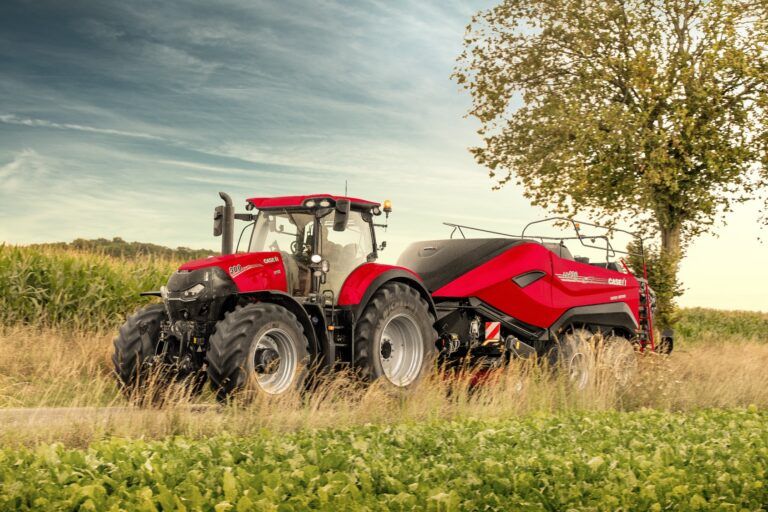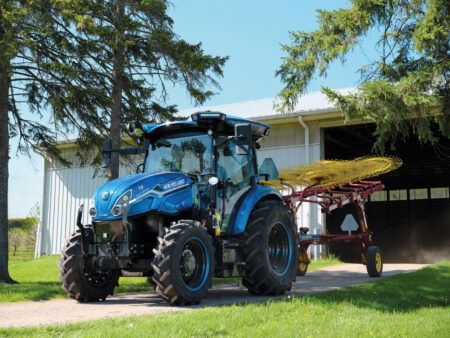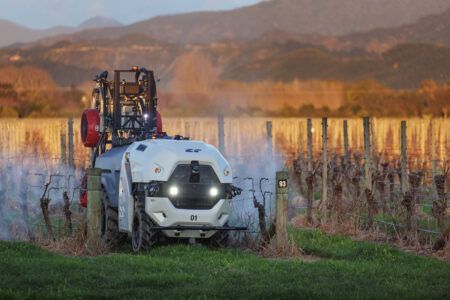Numbered amongst New Case IH’s mouthwatering machines at this year’s Agritechnica is the LB436 HD large square baler. Built for farmers seeking to pack more material into every bale to reduce handling requirements and transport costs, the LB436 HD is capable of creating bales with up to 22% greater density than the LB434 XL model, and at the same dimensions (120 x 90cm).
Features unique to the LB436 HD include a new main gearbox and mid-ship gearbox with gearshift overload protection for high power transfer and driveline safety. In addition, an innovative new twine knotter system is designed to boost productivity while eliminating field litter and bale contamination. The LB436 HD is fully ISObus Class 3 compatible, meaning not only can it be controlled from an ISObus terminal in the tractor cab, but the baler can also control the tractor’s actions, such as increasing forward speed in light areas of swaths, to automatically boost workrates.
High-strength construction
Built around a heavy-duty frame, the chassis of the LB436 HD has been constructed to withstand the loads imposed by a high-density system. The drawbar, kept short to aid visibility and manoeuvrability, is bolted to this, and is easily adjusted for the height of different tractor hitches, while the top section of the feeding chamber is an integral part. Benefits for the customer include minimal stress on both baler and tractor.
Pick-up units provide smoother, faster, fuller crop gathering
The 2.35m pick-up fitted to the LB436 HD features a mechanically-driven top-assist roller and roller windguard to ensure effective crop transition even in large swaths. Tines are steel coil types of 5.5mm diameter, and are set across five tine bars rather than the four of other Case IH LB models, for swift, clean crop gathering during the highest output baling. Pivotable gauge pick up wheels are an option.
The low friction and flat surfaces of new polypropylene pick-up tine guards provide improved crop flow and smoother feeding, with their lack of curved edges ensuring unimpeded sideways transition from the stub augers. The use of polypropylene also maximises guard lifetime because of its high flexibility and minimal deformation.
Fitted as standard with Rotor Cutter technology
The LB436 HD is equipped as standard with Case IH’s Rotor Cutter chopping system, incorporating 29 knives, with an adjustable knife selector allowing 7, 8, 14, 15 or 29 of these to be engaged. The knives are individually protected, and selection is indicated on the in-cab monitor.
Packing more into every bale – new levels of density
To begin baling, it is recommended to engage the tractor PTO at 850rpm. The baler flywheel will speed up in two stages, from 0-684rpm and then from 684-1,244rpm. A message displayed on the tractor’s ISOBUS display will then indicate that engagement of second gear is permitted and tractor engine speed can be increased to bring the PTO speed to 1,000rpm, raising the speed of the baler flywheel to its maximum 1,445rpm. As with other main elements of baler operation, ISOBUS control means the operator is fully informed and in control. With the Case IH AFS Pro 700 ISOBUS terminal, the operator now benefits from a new control layout that improves user-friendliness and ease of operation.
The LB436 HD features an adjustable pre-compression chamber with shearbolt protection and a plunger with a maximum speed of 48 strokes/min. Plunger stroke is longer than on the LB434 XL, to move the crop further into the bale chamber and prevent interference with the previous slice when feeding, while plunger force is increased by 150% over that of the LB434 XL, and it is secured by new bolted conrods. Repositioned haydogs improve the clamping of each flake, while new dampers reduce noise levels. The compression channel is longer, and while existing models feature two cylinders for compression, the LB436 HD uses seven, with bigger compression rings. All of these features are designed to ensure as much crop as possible is packed into each ram stroke that despatches material into the bale chamber, for maximum throughput.





